Abstract
Context:
Obsessive–compulsive disorder (OCD) is the fourth most common mental disorder and is diagnosed nearly as often as asthma and diabetes mellitus. Over the last decade, the inhibition of burying of glass marbles by mice has been used as an index of anti-OCD drug action in the so-called marble-burying test. Lagenaria siceraria (Molina) Standley (LS), commonly known as “bottle gourd” (English), possesses several medicinal properties; little is known about its action as a nerve tonic.
Objective:
The purpose of this study was to characterize the anti-OCD (anti-compulsive) activity of the methanolic extract of the fruits of L. siceraria (Molina) Standley (LS) using the marble-burying behavior in mice.
Materials and Methods:
The experiment was conducted in specific animal models of Swiss albino mice to evaluate marble-burying behavior.
Results and Conclusions:
Intraperitonial administration of 25 and 50 mg/kg of LS extract significantly (P < 0.001) decreased the total number of buried marbles. The effect was comparable to that of the fluoxetine (10 mg/kg, i.p.). Fluoxetine and LS fruit extract do not produce any overt motor dysfunction. Preliminary phytochemical screening of the methanolic extract of LS showed the presence of flavonoids, saponins, sterols, proteins, tannins and carbohydrates. The results of the study for the first time show that the plant possesses anti-compulsive (anti-OCD) activity, confirming the traditional claims. Future research should focus on the identification and the mechanism of action of the constituents from this plant.
Keywords: Fluoxetine, Lagenaria siceraria, marble-burying behavior, obsessive–compulsive disorder, preliminary phytochemical screening
INTRODUCTION
Obsessive–compulsive disorder (OCD) is characterized by persistent ritualistic thoughts (compulsions) which are ego-diatomic and associated with seemingly purposeful behaviors (compulsions).[1] Its co-morbidity with major depression is often evident, and it is considered as an anxiety disorder that is refractory to benzodiazepines.[2] Its lifetime prevalence rate is about 1–3%.[1] Only potent serotonin reuptake inhibitors (SSRIs) are consistently effective in patients of OCD.[3]
Marble-burying behavior of mice simulates some aspects of obsessive-compulsive behavior; therefore, it is often used to screen anti-compulsive drugs due to high predictive and good face validity.[4] In both natural and laboratory conditions, rats and mice spontaneously use the available bedding material to bury unpleasant sources of discomfort present in their home environment.[5] Burying behavior consists in forward shoving the diggable material over the source of aversion, using the snout and forepaws in order to avoid and protect from the localized threat.[6] This characteristic behavior, which is usually directed toward several classes of harmful and noxious objects such as food associated with unpleasant taste, small predators such as scorpions, dead conspecifics or electrified prod, is described as a defensive behavior reflecting the anxiety state of animals.[7–9] However, whereas the defensive nature of marble-burying behavior is still actively debated, the mouse marble-burying test has been used as a screening model for the detection of anxiolytics.
Lagenaria siceraria (Molina) Standley (LS) syn. Lagenaria leucantha Rusby; (Family: Cucurbitaceae) is commonly known as “Bottle gourd” [Figure 1], and is an excellent natural fruit with all the essential constituents that are required for normal and good health of humans.[10] LS fruits are traditionally used for their cardioprotective, cardiotonic, general tonic, aphrodisiac properties and act as an alternate purgative and a diuretic.[11,12] It also cures pain, ulcers, fever, and is used for pectoral cough, asthma and other bronchial disorders.[11] The fruits are edible and considered as a good source of vitamin C, β-carotene, vitamin B-complex, pectin and also contain highest choline level (a lipotropic factor).[10,13] Modern phytochemical screening methods have shown the presence of triterpenoid cucurbitacins B, D, G, H, fucosterol, campesterol and flavone C-glycosides in it.[14–18]
Figure 1.
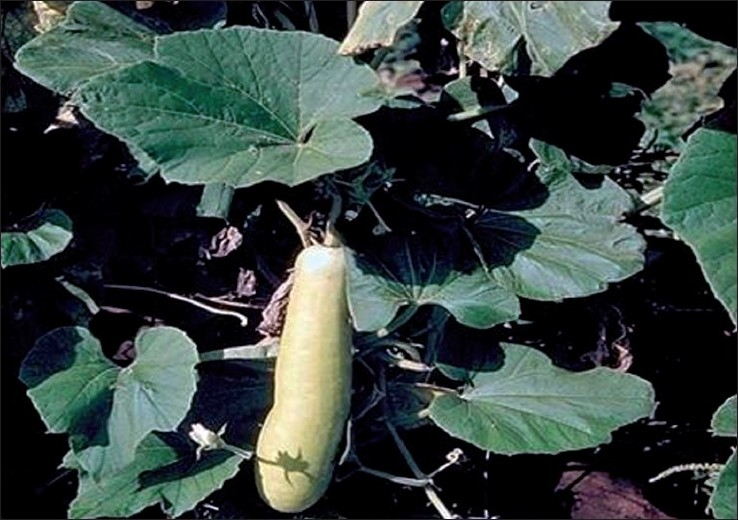
Whole plant of Lagenaria siceraria
The purpose of the study was to evaluate anti-compulsive effects of methanolic extract of LS by using behavioral test of marble burying. The extract was also studied for its acute toxicity effects and preliminary phytochemical screening.
MATERIALS AND METHODS
Collection and authentication of plant material
Fresh fruits of LS were purchased from a local market of Rajkot, Gujarat. The plant was identified and authenticated by Prof. P. J. Parmar, Botanical Survey of India, Jodhpur. A specimen voucher (SU/DPS/Herb/05) [Figure 2] of the plant has been deposited at Department of Pharmaceutical Sciences, Saurashtra University, Rajkot, for future reference.
Figure 2.
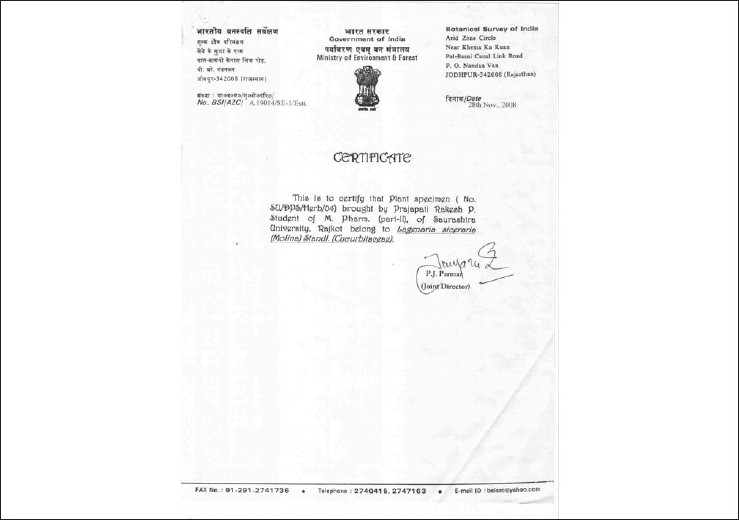
Herbarium authentication certifi cate
Extraction of plant material
LS fruits were properly cleaned and cut into thin round slices and dried. The dried plant material was then made into a coarse powder. The coarsely powdered dried fruits of LS (20 g) were extracted with petroleum ether by hot extraction process (Soxhlet extraction) for 4 hours. After completion of the extraction, the solvent was removed by distillation and concentrated in vaccuo and stored at freezing temperature. Further extract was subjected to preliminary phytochemical screening[19] for the detection of various plant constituents.
Preparation of test extracts and treatments
Methanolic crude extract of LS was suspended in 1% w/v carboxy methyl cellulose (CMC) in distilled water and administered via i.p. route. Extract was administered at dose levels of 25 and 50 mg/kg. Control group animals received only vehicle (1% w/v CMC) and standard group animals received reference standard drug, fluoxetine (10 mg/kg, i.p.) (Torrent pharmaceuticals Ltd., Ahmedabad, India), a drug of choice in SSRI category. All the drugs as well as extracts were freshly prepared and administered 30 minutes prior to test.
Experimental animals
Adult Swiss albino mice (25–30 g) were group housed (n = 6) under a standard 12 hour light/dark cycle and controlled conditions of temperature and humidity (25 ± 2°C, 55–65%). Mice received standard rodent chow (Pranav Agro Sales., Ahmedabad, India) and water ad libitum. Mice were acclimatized to laboratory conditions for 7 days before carrying out the experiments. All the experiments were carried out in a noise-free room between 0800 and 1500 hours. Separate groups (n = 6) of mice were used for each set of experiments. The animal studies were approved (protocol approval no. SU/DPS/IAEC/9001) by the Institutional Animal Ethics Committee (IAEC), constituted for the purpose of control and supervision of experimental animals by Ministry of Environment and Forests, Government of India, New Delhi.
Acute toxicity study
The methanolic extract of LS at doses of 25, 50, 75, 100, 150, 200, 250 and 300 mg/kg was administered intraperitoneally to groups of 5–10 animals each. The animals were examined every 30 minutes up to a period of 3 hours and then, occasionally, for further 4 hours; finally, the parameters such as hyperactivity, grooming, convulsions, sedation, hypothermia and mortality were recorded. The LD50 was calculated as described by Litchfield and Wilcoxon (1949).[20] The following tests were performed at two dose levels of 25 and 50 mg/kg body weight corresponding to 10 and 20% of LD50 value (250 mg/kg), respectively, in order to assess the anti-compulsive activity of test drug.
Assessment of marble-burying behavior
The anti-compulsive effect was assessed by the widely used model of studying the marble-burying behavior of mice.[21,22] Marble-burying behavior of mice was studied as described previously.[21–23] In brief, each mouse was individually placed in a plastic cage (21 × 38 × 14 cm) containing 5-cm thick sawdust bedding. Twenty small glass marbles (diameter 10–12 mm) were arranged on the bedding, evenly spaced in four rows Figure 3. After 30 minute exposure, the number of unburied marbles was counted. A marble covered at least two-third of its size by saw dust was considered as “buried”.
Figure 3.
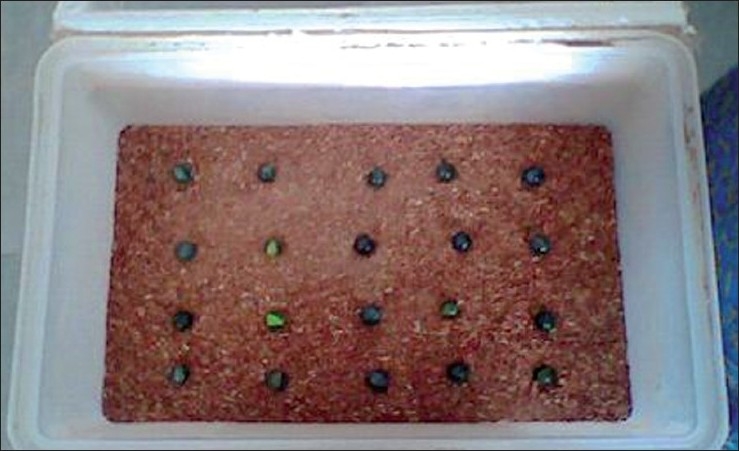
Animal model for assessment marble burying behavior
Statistical analysis
All data were expressed as mean ± SEM (n = 6) and analyzed by one-way analysis of variance (ANOVA), followed by Student Newman-Keuls test. The groups treated with extracts and fluoxetine were compared with the respective vehicle group. P values <0.001 were considered statistically significant.
RESULTS
Preliminary phytochemical screening
Preliminary phytochemical screening [Table 1] of the methanolic extract of LS showed the presence of flavonoids, saponins, sterols, proteins, tannins and carbohydrates.
Table 1.
Result of phytochemical screening of methanolic extract of L. siceraria fruits
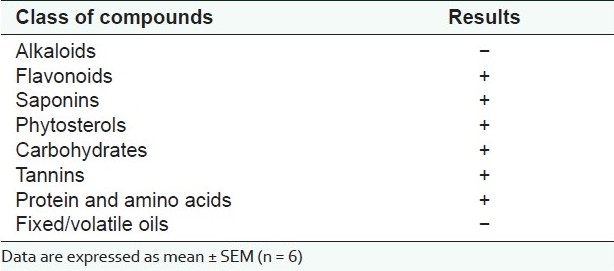
Effect on marble-burying behavior in mice
Methanolic extract of LS fruits (25 and 50 mg/kg, i.p.) dose dependently reduced marble-burying behavior in mice [Table 2] and the reduction was significant (P < 0.001) as compared to control group. Fluoxetine, at a dose of 10 mg/kg, also showed significant (P < 0.001) reduction in the number of buried marbles [Table 2, Figure 4].
Table 2.
Effect of methanolic extract of L. siceraria fruits (LSFE) and fluoxetine on marbleburying behavior in mice

Figure 4.
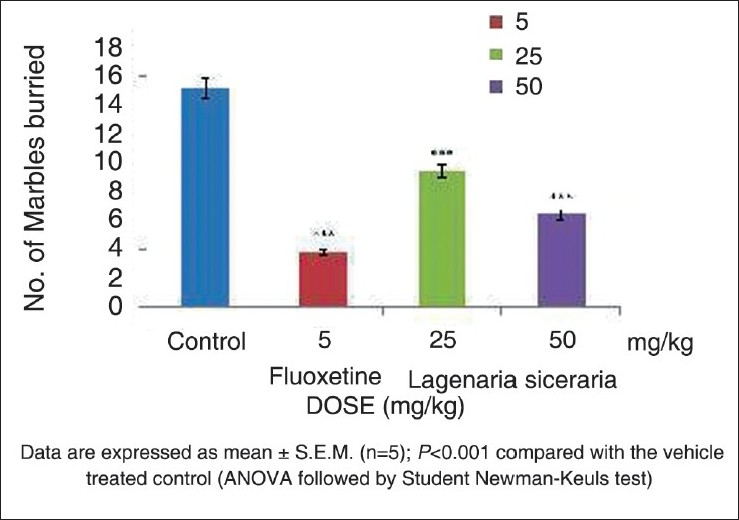
Effect of methanolic extract of LS fruits and fl uoxetine on marble-buying behavior (MBT) in mice
DISCUSSION
This is the first report to show that LS fruit can modulate the compulsive behavior. These studies were carried out by employing an animal model, and the marble-burying behavior of mice was considered as the marker index of compulsive behavior characteristically evident in OCD. Marble-burying behavior is an unconditioned, specific defensive reaction in rodents, which is not associated with physical danger and does not habituate upon repeated testing.[21] In male mice, it is markedly attenuated by acute administration of SSRI and tricyclic antidepressants.[24] These observations suggest that the burying behavior in male mice models can be useful for evaluation of compulsive behavior rather than anxiety.[25] Therefore, this paradigm was employed in the present investigations. The present study revealed that LS fruit extract (25 and 50 mg/kg., i.p.) reduced marble-burying behavior and the effect was comparable with that of fluoxetine (10 mg/kg, i.p.).
According to pathophysiology, OCD has been linked to abnormalities with the neurotransmitter serotonin, although it could be either a cause or an effect of these abnormalities. Serotonin is thought to have a role in regulating anxiety. To send chemical messages from one neuron to another, serotonin must bind to the receptor sites located on the neighboring nerve cell. It is hypothesized that the serotonin receptors of OCD sufferers may be relatively understimulated. This suggestion is consistent with the observation that many OCD patients benefit from the use of SSRIs, a class of antidepressant medications that allow for more serotonin to be readily available to other nerve cells.[26] So, it can be assumed that methanolic extract of LS may have an identical effect to SSRI or some inhibitory effect on serotonergic neurotransmission.In the present study, phytochemical screening on fruits of LS revealed the presence of flavonoids, steroids, saponins, terpenes and phenolic compounds, so it is possible that the mechanism of anti-compulsive action of LS may be due to involvement of any of these phytoconstituents in serotonergic neurotransmission. Moreover, triterpepenoids (steroidal compounds), which are able to cross blood brain barrier (BBB) due to their lipophilic nature, are present in the LS fruits. So, it can be assumed that such compounds might also be responsible to elicit anti-compulsive activity at a molecular level in central nervous system (CNS; brain).[27]
CONCLUSION
This is the first report to show that methanolic extract of LS dose dependently attenuated marble-burying behavior in mice, and the effect was comparable to that shown by fluoxetine, a reference standard drug. The present study concludes that the methanolic extract of LS fruits shows anti-compulsive (anti-OCD) effect in dose-dependent manner. Phytochemical screening of the extract has shown the presence of flavonoids, saponins and steroids, which may account for biological activities. In the same way, identification and isolation of compound(s) responsible for the activity could be used as prototype(s) to design new substances with anti-OCD activity. Further major active components and precise anti-compulsive mechanisms need to be identified.
Acknowledgments
We are grateful to the Head, Department of Pharmaceutical Sciences, Saurashtra University, Rajkot, Gujarat, India, for providing the facilities during the course of this study. Special thanks to Prof. P. J. Parmar, Botanical Survey of India, for identification and authentication of the plant.
Footnotes
Source of Support: Nil,
Conflict of Interest: None declared.
REFERENCES
- 1.Rasmussen SA, Eisen JL. The epidemiology and clinical features of obsessive- compulsive disorder. Psychiatr Clin North Am. 1992;15:743–58. [PubMed] [Google Scholar]
- 2.Bartz JA, Hollander E. Is obsessive-compulsive disorder an anxiety disorder? Prog Neuro-psychopharmacol Biol Psychiatry. 2006;30:338–52. doi: 10.1016/j.pnpbp.2005.11.003. [DOI] [PubMed] [Google Scholar]
- 3.El Mansari M, Blier P. Mechanisms of action of current and potential pharmacotherapies of obsessive-compulsive disorder. Prog Neuropsychopharmacol Biol Psychiatry. 2006;30:362–73. doi: 10.1016/j.pnpbp.2005.11.005. [DOI] [PubMed] [Google Scholar]
- 4.Joel D. Current animal models of obsessive-compulsive disorder: A critical review. Prog Neuropsychopharmacol Biol Psychiatry. 2006;30:374–88. doi: 10.1016/j.pnpbp.2005.11.006. [DOI] [PubMed] [Google Scholar]
- 5.Archer T, Fredriksson A, Lewander T, Soderberg U. Marble burying and spontaneous motor activity in mice: Interactions over days and the effect of diazepam. Scand Psychol. 1987;28:242–9. doi: 10.1111/j.1467-9450.1987.tb00761.x. [DOI] [PubMed] [Google Scholar]
- 6.Poling A, Cleary J, Monaghan M. Burying by rats in response to aversive and nonaversive stimuli. J Exp Anal Behav. 1981;35:31–44. doi: 10.1901/jeab.1981.35-31. [DOI] [PMC free article] [PubMed] [Google Scholar]
- 7.Wilkie DM, MacLennan AJ, Pinel JP. Rat defensive behavior: Burying noxious food. J Exp Anal Behav. 1979;31:299–306. doi: 10.1901/jeab.1979.31-299. [DOI] [PMC free article] [PubMed] [Google Scholar]
- 8.Londei T, Valentini AM, Leone VG. Investigative burying by laboratory mice may involve non-functional, compulsive behaviour. Behav Brain Res. 1998;94:249–54. doi: 10.1016/s0166-4328(97)00162-9. [DOI] [PubMed] [Google Scholar]
- 9.Treit D. A comparison of anxiolytic and nonanxiolytic agents in the shockprobe/burying test for anxiolytics. Pharmacol Biochem Behav. 1990;36:203–305. doi: 10.1016/0091-3057(90)90151-7. [DOI] [PubMed] [Google Scholar]
- 10.Rahman AS. Bottle Gourd (Lagenaria siceraria)-a vegetable for good health. Natural Product Radiance. 2003;2:249–50. [Google Scholar]
- 11.Shinrajan VV, Balachandra I. Ayurvedic Drugs and their plant source. New Delhi: Oxford and IBH Publishers; 1996. pp. 176–7. [Google Scholar]
- 12.Kirtikar KR. Indian medicinal plants. Dehradun, India: Oriental Enterprises; 2001. pp. 723–3. [Google Scholar]
- 13.Chopra RN, Chopra IC, Verma BS. Supplement of Glossary if Indian Medicinal plants. New Delhi: Council of Scientific and Industrial Research; 1992. p. 51. [Google Scholar]
- 14.Duke JA. Handbook of Phytochemical and Constituents of Grass herbs and other economic plants. Boco, Raton, FL: CrC Press; 1999. pp. 98–119. [Google Scholar]
- 15.Evans WC, Treese GD. Pharmacognosy. London: Balliere, Tindall; 1996. pp. 388–433. [Google Scholar]
- 16.Sonja S, Hermann S. Analysis of Curcubitacins in medicinal Plants by HPLC-MS. Phytochem Analysis. 2000;11:121. [Google Scholar]
- 17.Shirwaikar A, Sreenivasan KK. Chemical investigation and anti-hepatotoxic activity of the fruits of Lagenaria siceraria. Ind J Pharm Sci. 1996;58:197–202. [Google Scholar]
- 18.Baranowska MK, Cisowski W. High Performance Liquid Chromatographic determination of Flavone C-glycosides in some species of the Curcubiraceae family. J Chromatography A. 1994;675:240–3. [Google Scholar]
- 19.Khandelwal KR. Preliminary phytochemical screening. 6th ed. Pune: Nirali Prakashan; 2006. pp. 149–53. [Google Scholar]
- 20.Litchfield JT, Wilcoxon F. Simplified method of evaluation of dose-effect experiments. J Pharmacol. 1949;96:99–113. [PubMed] [Google Scholar]
- 21.Njung’e K, Handley SL. Evaluation of marble-burying behavior as a model of anxiety. Pharmacol Biochem Behav. 1991a;38:63–7. doi: 10.1016/0091-3057(91)90590-x. [DOI] [PubMed] [Google Scholar]
- 22.Njung’e K, Handley SL. Effects of 5-HT uptake inhibitors, agonists and antagonists on the burying of harmless objects by mice; a putative test for anxiolytic agents. Br J Pharmacol. 1991b;104:105–12. doi: 10.1111/j.1476-5381.1991.tb12392.x. [DOI] [PMC free article] [PubMed] [Google Scholar]
- 23.Gaikwad U, Bhutada P, Wanjari M, Umathe S. LHRH antagonist attenuates the effect of fluoxetine on marble-burying behavior in mice. Eu J Pharmacol. 2007;563:155–9. doi: 10.1016/j.ejphar.2007.02.016. [DOI] [PubMed] [Google Scholar]
- 24.Ichimaru Y, Egawa T, Sawa A. 5-HT1A-receptor subtype mediates the effect of fluvoxamine, a selective serotonin reuptake inhibitor, on marble-burying behavior in mice. Jpn J Pharmacol. 1995;8:65–70. doi: 10.1254/jjp.68.65. [DOI] [PubMed] [Google Scholar]
- 25.Milla MJ, Dekeyne A, Papp M, La Rochelle CD, Macsweeny C, Peglion JL, et al. S33005, a novel ligand at both serotonin and norepinephrine transporters: II. Behavioral profile in comparison with venlafaxine, reboxetine, citalopram and clomipramine. J Pharmacol Exp Ther. 2001;298:581–91. [PubMed] [Google Scholar]
- 26.BBC Science and Nature: Human Body and Mind. Causes of OCD. [last accessed on 2006 Apr 15]. Available from: http://www.bbc.co.uk/science/humanbody/mind/articles/disorders/causesofocd.shtml .
- 27.Librowaski P, Czarapki R, Mendyk A, Jastrzebska M. Influence of new monoterpene homologous of GABA on the CNS activity in mice. Pol J Pharmacol. 2000;52:317–21. [PubMed] [Google Scholar]


